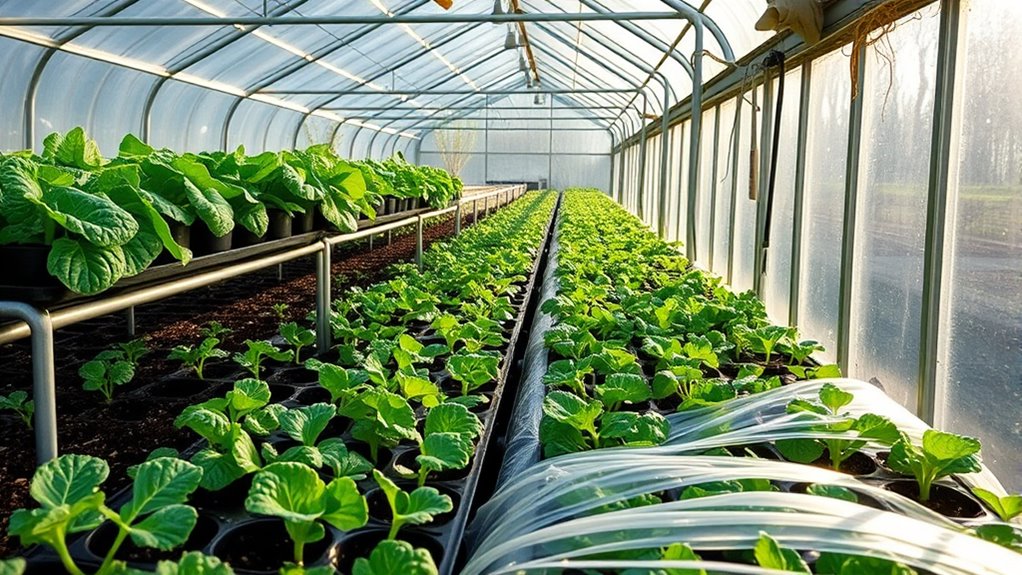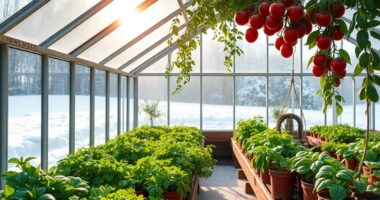To start cool-season crops in your greenhouse early spring, begin by testing and amending your soil with compost to enhance fertility and drainage. Keep the environment cool and well-ventilated, using shades or covers to prevent overheating. Water consistently without overdoing it, and regularly check for pests or diseases. Good sanitation and crop rotation help maintain healthy conditions. If you follow these steps, you’ll set a strong foundation for thriving crops—continue to discover more tips and strategies.
Key Takeaways
- Prepare well-draining, nutrient-rich soil with organic amendments and ensure it’s evenly moist before planting.
- Select appropriate cool-season crops like lettuce, spinach, kale, broccoli, or radishes for early spring growth.
- Use shading or ventilation to regulate greenhouse temperatures and prevent overheating during warm days.
- Cover seedlings with row covers or lightweight fabrics for pest protection and weather resilience.
- Regularly monitor and maintain optimal soil moisture, pest control, and sanitation for healthy crop development.

As early spring arrives, it’s the perfect time to start planting cool-season crops in your greenhouse. To guarantee a successful start, focus on proper soil preparation. Begin by testing your soil’s pH and nutrient levels to determine what amendments are necessary. Cooler-season crops thrive in well-draining, fertile soil, so consider adding compost or aged manure to boost organic matter. Loosen the soil to improve aeration and root penetration, and make sure it’s evenly moist but not waterlogged. This creates an ideal environment for seedlings to develop strong roots and healthy growth right from the start.
Once your soil is prepared, it’s vital to pay attention to pest management. Early spring is often when pests begin to emerge, and a clean, healthy greenhouse can help minimize infestations. Remove any plant debris or weeds that could harbor pests or diseases, and sanitize your containers and tools before planting. Using integrated pest management practices, like introducing beneficial insects or applying organic treatments, can keep pests at bay without harming your crops. Regularly inspect your seedlings for signs of trouble, such as discolored leaves or holes, so you can catch problems early and address them promptly.
Prioritize pest management by removing debris, sanitizing tools, and inspecting seedlings regularly.
Timing is key when starting cool-season crops in early spring. Plant crops like lettuce, spinach, kale, broccoli, and radishes directly into the prepared soil or seed trays. Keep in mind that these crops prefer cooler temperatures, so avoid planting during the hottest part of the day or when the greenhouse is excessively warm. Use shading or ventilation to regulate the temperature, ensuring the environment stays within the ideal range for growth. Covering seedlings with row covers or lightweight fabric can also provide protection from pests and harsh weather, giving your plants a better chance to establish.
Watering is equally important. Maintain consistent moisture, but be careful not to overwater, as soggy soil can promote fungal diseases. Use a gentle spray or watering can to keep the soil evenly moist, especially during the early stages when seedlings are most vulnerable. As your plants grow, keep monitoring for pests and signs of disease, and take swift action if needed. Regularly rotating crops and practicing good sanitation will help keep pests and diseases from becoming persistent problems.
Additionally, remote work offers an opportunity to dedicate more time to caring for your plants and maintaining your greenhouse, ultimately leading to healthier crops. Starting your cool-season crops in early spring requires attention to soil health and vigilant pest management. With proper preparation and ongoing care, you’ll set a strong foundation for a productive greenhouse season. Your efforts now will pay off with healthy, vigorous plants ready to harvest when the weather warms up.
Frequently Asked Questions
What Are the Best Temperature Ranges for Early Spring Greenhouse Crops?
You should keep your greenhouse temperatures between 55-75°F for cool-season crops, ensuring they stay within their plant hardiness zones. Maintaining consistent temperatures helps prevent stress and promotes healthy growth. Prioritize soil preparation by ensuring it’s well-drained and rich in organic matter. Use a thermometer to monitor conditions regularly, adjusting ventilation or heating as needed. This approach creates an ideal environment for early spring crops to thrive.
How Do I Prevent Pests in Early Spring Greenhouse Conditions?
Pest prevention in your greenhouse is like building a fortress—strong and vigilant. You should regularly conduct pest monitoring to catch issues early. Introduce natural predators, such as ladybugs or predatory mites, to keep pests in check naturally. Keep your greenhouse clean, remove weeds, and avoid overwatering. These simple steps create an environment that’s less inviting to pests, ensuring your cool-season crops stay healthy and productive all spring long.
What Lighting Adjustments Are Needed for Cool-Season Crops?
You should adjust your lighting schedules to support cool-season crops by providing 12-16 hours of light daily, mimicking natural daylight. Supplemental lighting, like LED grow lights, helps compensate for shorter winter days and low sunlight. Keep lights on during the day if needed, especially on cloudy days, ensuring your plants receive consistent, adequate illumination to promote healthy growth and ideal development in early spring.
How Often Should I Water Newly Started Crops?
You should water newly started crops when the top inch of soil feels dry, typically every 1-2 days, depending on your greenhouse’s humidity and temperature. Don’t let the soil dry out completely, as this can stress young plants. Consistent watering frequency helps maintain ideal soil moisture management, encouraging healthy root development. Visualize the soil staying just moist enough to support vibrant, strong growth without becoming soggy or waterlogged.
Can I Extend the Growing Season With Specific Greenhouse Modifications?
Yes, you can extend your growing season with specific greenhouse modifications. By adding insulation, installing thermal curtains, and using supplemental heating, you create a more controlled environment that protects your crops from cold temperatures. These season extension techniques help you grow cool-season crops longer into spring or even fall. Proper ventilation and shading also prevent overheating, ensuring your greenhouse remains an ideal space for healthy crop growth year-round.
Conclusion
As you usher these cool-season crops into your greenhouse, you’re planting the seeds of resilience and freshness. Think of your greenhouse as a cozy cradle, nurturing new life before the world warms up. With each careful step, you’re crafting a green sanctuary where vibrant greens and hardy vegetables thrive against the odds. Embrace this early spring ballet—your thumbs turning green, your garden bursting with promise, ready to flourish in the warm embrace of your careful care.









